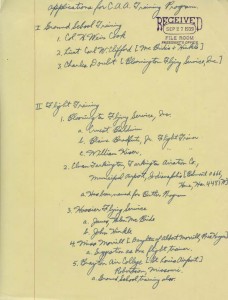In the years leading up to World War II there was an escalating climate of unsolicited preparedness. With a certain level of foresight, several countries in Europe, such as Italy and Germany, began government-sanctioned pilot training for civilians. The United States was quick to follow suit, and in 1939 the Civilian Pilot Training Program (CPTP), a program designed to nest within eligible colleges and universities, was formed under the supervision of the Civilian Aeronautics Authority (CAA). The CAA began accepting applications from interested academic institutions and Indiana University, at the urging of President Herman B Wells, was among the first to apply.

At that time, Bloomington did not have an airport with suitable facilities for the program; nevertheless, the CAA accepted IU’s application contingent on the completion of a new municipal airport, which the City of Bloomington, under the auspices of the Works Projects Administration (WPA), intended to complete by September of 1940. The WPA had approved a $306,000 budget for construction of this new, “modern” airport. When completed the airport would boast classroom space set aside specifically for the CPTP and four runways varying between 2500 and 4000 feet in length. In the meantime IU was authorized to begin the program with somewhat lower numbers of trainees than completion of the airport would eventually allow for.
Eligible students were required to pass a physical examination and submit a laboratory fee of $40, a small sum according to the CAA, which claimed that the course was valued at $500. Colonel John F. Landis, professor of military science and tactics at IU, was chosen as director of the program. Ground school classes, which included such topics as the history of aviation, the theory of flight, meteorology, navigation and civil air regulations, began on January 8th, 1940. Lieutenant Charles Daudt, professor of aviation, was instructor for the first ground school course. Students were required to complete 72 hours of ground school curriculum, in addition to 35 to 50 hours of actual flight training. The flight training was split into three different stages: dual instruction, primary solo flight and practice, as well as advanced solo flight and practice. After completion of the ground school and flight training requirements, pilots-in-training were required to complete a private flight test. It is unclear exactly where the CPTP students underwent their hands-on flight instruction and practice, but some correspondence refers to the site of the “old airport,” which may allude to the Bloomington Airport once located on White Hall Pike. Graduates of the first CPTP class included 28 men and 1 woman.
It is interesting to note that not everyone was as supportive of the program as President Wells. In retrospect, the motives behind the establishment of the CPTP may seem obvious, but when the program began there was still a generally ambivalent attitude on involving the United States in a foreign war which had not yet hit home, so to speak. Pearl Harbor, the event which is attributed to spurring the U. S. into the second world war was still over a year away when the CPTP was getting started. So, while the training program was praised and welcomed by some, others were not so favorably impressed. Edwin C. Johnson, a Democrat and two time governor of Colorado (1933-1937, 1955-1957) published a pamphlet in the early spring of 1940 entitled “Mars In Civilian Disguise.” The pamphlet set out to “expose” and criticize the program for essentially being “a camouflage for a definitely militaristic project,” a project that was attempting, from the very start, to propel the American people down a war path.
In contrast, President Herman B Wells, along with other members of the administration and student body were enthusiastic about the program from the very start. In a letter to Robert H. Hinckley of the CAA, President Wells stated that the CPTP “[had] been a splendid addition” to IU’s educational offerings. Along with Col. Landis, Wells worked hard to convince the CAA to increase IU’s allotted quota of students from thirty to fifty, but the CAA insisted upon completion of the Bloomington Municipal Airport before allowing IU to increase its numbers. The goal was to eventually allow for three groups of fifty students to be trained per year. While several more CPTP graduating classes were ushered through the program from 1940 to the summer of 1941, problems arose when construction of the airport did not progress as planned. As a result, the CPTP was temporarily discontinued and re-implemented shortly thereafter following completion of the airport. As far as we know the program continued through the early part of 1942. At some point the Civilian Pilot Training Program was shut down permanently at IU, although the CPTP would continue at other universities across the United States through 1944.
Further research is needed to definitely answer the question of what caused the permanent shut down of the Civilian Pilot Training Program at IU. Perhaps it was due to inadequate facilities at the new airport, or perhaps it was a decline in interest. About a dozen files pertaining to the CPTP are located in Herman B Wells’ President’s Office Records. If you are interested in learning more about IU’s short-lived Civilian Pilot Training Program, please contact us at the Archives.
Leave a Reply